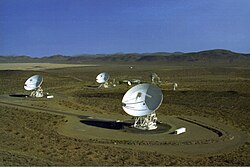Goldstone Deep Space Communications Complex
 Goldstone Deep Space Network | |||||||||||
| Alternative names | Goldstone Observatory | ||||||||||
|---|---|---|---|---|---|---|---|---|---|---|---|
| Organization | NASA, JPL, Caltech | ||||||||||
| Location | Mojave Desert (near Barstow), San Bernardino County, California, USA | ||||||||||
| Coordinates | 35°25′36″N 116°53′24″W / 35.42667°N 116.89000°W | ||||||||||
| Established | Summer 1958 | ||||||||||
| Website | http://deepspace.jpl.nasa.gov/dsn/ | ||||||||||
| Telescopes | |||||||||||
| |||||||||||
| | |||||||||||
Pioneer Deep Space Station | |
 Pioneer Deep Space Station | |
| Location | Goldstone Deep Space Communications Complex, Fort Irwin, California |
|---|---|
| Area | less than 1-acre (4,000 m2)[1] |
| Built | 1958 |
| Architect | U.S. Army |
| Architectural style | No Style Listed |
| NRHP reference No. | 85002813 |
| Significant dates | |
| Added to NRHP | October 3, 1985[2] |
| Designated NHL | October 3, 1985[3] |
The Goldstone Deep Space Communications Complex (GDSCC) — commonly called the Goldstone Observatory — is located in California's Mojave Desert. Operated by ITT Corporation for the Jet Propulsion Laboratory, its main purpose is to track and communicate with space missions. It includes the Pioneer Deep Space Station, which is a U.S. National Historic Landmark. The current observatory is part of NASA's Deep Space Network. The Goldstone Deep Space Communications Complex is one of just three in the world; the others being the Madrid Deep Space Communication Complex and the Canberra Deep Space Communication Complex.
Antennas
Goldstone antennas have also been used as sensitive radio telescopes for such scientific investigations as mapping quasars and other celestial radio sources; radar mapping planets, the Moon, comets and asteroids; spotting comets and asteroids with the potential to strike Earth; and the search for ultra-high energy neutrino interactions in the moon by using large-aperture radio antennas.[4]

"Goldstone has the bird"
It is commonly believed that the first U.S. satellite, Explorer I, was confirmed to be in orbit by the use of the phrase "Goldstone has the bird". However, Goldstone was not in operation at the time of Explorer I, and like many oft-repeated quotations it is a misquote. The actual phrase was "Gold has it!"[5] "Gold" was not an abbreviation of Goldstone, but code for a temporary tracking station at Earthquake Valley in the Anza-Borrego desert.
Commemoration
The Pioneer Deep Space Station was declared a National Historic Landmark in 1985.[1][3]
Complex tours
The Goldstone Deep Space Communications Complex conducts tours of its facility and museum to middle and high schools, as well as individuals interested in visiting.
See also
References
- ^ a b Harry A. Butowsky (May 15, 1984). "National Register of Historic Places Inventory-Nomination:" (Document). National Park Service.
{{cite document}}: Unknown parameter|accessdate=ignored (help); Unknown parameter|format=ignored (help); Unknown parameter|url=ignored (help) and Template:PDFlink - ^ "National Register Information System". National Register of Historic Places. National Park Service. January 23, 2007.
- ^ a b "Apollo Deep Space Station". National Historic Landmark summary listing. National Park Service. Retrieved 2008-03-20.
- ^ "A Search for Ultra-High Energy Neutrino Interactions in the Moon Using Large-Aperture Radio Antennas". UCLA. Retrieved 2008-03-28.
- ^ The First Explorer Satellites lecture by George H. Luwig, 9 Oct 2004
External links
- http://www.gdscc.nasa.gov/index.html
- Goldstone tours
- NASA's Deep Space Network
- JPL: Images of the Deep Space Network Goldstone, California
- JPL: Images of the Deep Space Network Goldstone, California
- JPL Communications Systems and Research Section 332 Website
- Historic 'Mars antenna' in Mojave Desert undergoing repairs (Los Angeles Times, October 3, 2010)
- Overview of World's Toughest Fixes episode about repair of 70 meter antenna
- http://www.gdscc.nasa.gov/index.html


